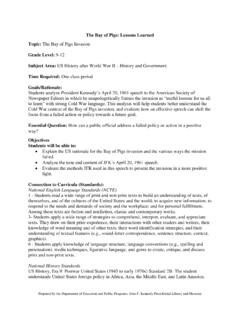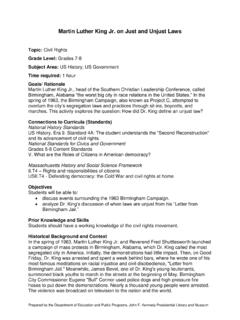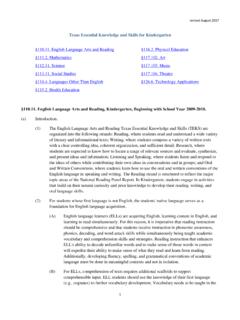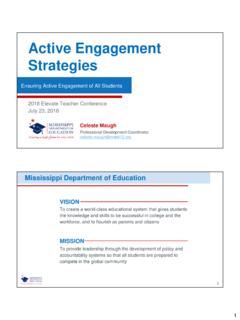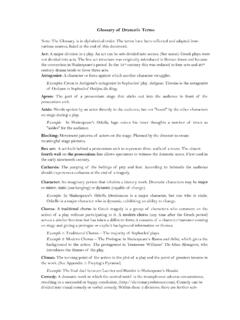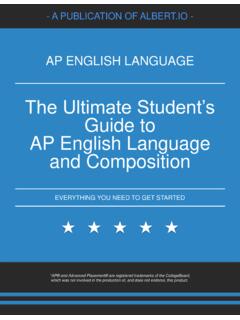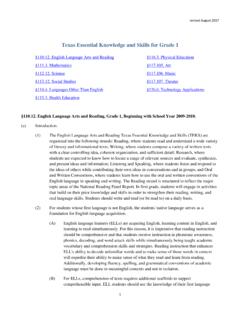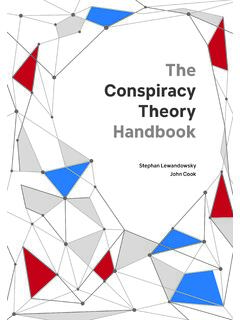Transcription of Analyzing the Rhetoric of JFK’s Inaugural Address
1 Prepared by the Department of Education and Public Programs, John F. Kennedy Presidential Library and Museum Analyzing the Rhetoric of JFK s Inaugural Address Topic: John F. Kennedy s Inaugural Address Grade Level: 9-12 Subject Area: English Language Arts Time Required: 1-2 class periods Goals/Rationale An Inaugural Address is a speech for a very specific event being sworn into the office of the presidency. The speeches of modern presidents share some commonalities in referencing American history, the importance of the occasion, and hope for the future. Each president, however, has faced the particular challenges of his time and put his own distinctive rhetorical stamp on the Address . In the course of writing this Address , John F.
2 Kennedy and Theodore Sorensen, his advisor and main speechwriter, asked for and received suggestions from advisors and colleagues. (To see the telegram from Ted Sorensen dated December 23, 1960, visit ) In his delivered speech, Kennedy included several sections of text provided by both John Kenneth Galbraith, an economics professor at Harvard University and Adlai Stevenson, former governor of Illinois and Democratic presidential candidate in 1952 and 1956. In this lesson plan, students consider the rhetorical devices in the Address JFK delivered on January 20, 1961. They then analyze the suggestions made by Galbraith and Stevenson and compare them to the delivered version of the speech. Students then evaluate the impact of the changes on the resonance of the speech.
3 Essential Question: How can the use of rhetorical devices enhance a speech? Objectives Students will: identify rhetorical terms and methods. examine the rhetorical devices of JFK s Inaugural Address . analyze the effects of the rhetorical devices on the delivered speech. Connections to Curriculum (Standards) National English Language Standards (NCTE) Prepared by the Department of Education and Public Programs, John F. Kennedy Presidential Library and Museum 1 - Students read a wide range of print and non-print texts to build an understanding of texts, of themselves, and of the cultures of the United States and the world; to acquire new information; to respond to the needs and demands of society and the workplace; and for personal fulfillment.
4 Among these texts are fiction and nonfiction, classic and contemporary works. 3- Students apply a wide range of strategies to comprehend, interpret, evaluate, and appreciate texts. They draw on their prior experience, their interactions with other readers and writers, their knowledge of word meaning and of other texts, their word identification strategies, and their understanding of textual features ( , sound-letter correspondence, sentence structure, context, graphics). 4 - Students adjust their use of spoken, written, and visual language ( , conventions, style, vocabulary) to communicate effectively with a variety of audiences and for different purposes. Students employ a wide range of strategies as they write and use different writing process elements appropriately to communicate with different audiences for a variety of purposes.
5 6 - Students apply knowledge of language structure, language conventions ( , spelling and punctuation), media techniques, figurative language, and genre to create, critique, and discuss print and nonprint texts. MA Framework : Identify rhetorically functional sentence structure. : Evaluate how an author s choice of words advances the theme or purpose of a work. : Identify, analyze and evaluate an author s use of rhetorical devices in persuasive argument. Historical Background and Context On January 20, 1961, a clerk of the Supreme Court held the large Fitzgerald family Bible as John F. Kennedy took the oath of office to become the nation s 35th president. Against a backdrop of deep snow and sunshine, more than twenty thousand people huddled in 20-degree temperatures on the east front of the Capitol to witness the event.
6 Kennedy, having removed his topcoat and projecting both youth and vigor, delivered what has become a landmark Inaugural Address . His audience reached far beyond those gathered before him to people around the world. In preparing for this moment, he sought both to inspire the nation and to send a message abroad signaling the challenges of the Cold War and his hope for peace in the nuclear age. He also wanted to be brief. As he d remarked to his close advisor, Ted Sorensen, I don t want people to think I m a windbag. He assigned Sorensen the task of studying other Inaugural speeches and Lincoln s Gettysburg Address to glean the secrets of successful addresses. The finely-crafted delivered speech had been revised and reworked numerous times by Kennedy and Sorensen until the President-elect was satisfied.
7 Though not the shortest of Inaugural addresses, Kennedy s was shorter than most at 1,355 words in length and, like Lincoln s famous speech, was comprised of short phrases and words. In addition to message, word choice and length, he recognized that captivating his audience required a powerful delivery. On the day before and on the morning of Inauguration Prepared by the Department of Education and Public Programs, John F. Kennedy Presidential Library and Museum Day, he kept a copy handy to take advantage of any spare moment to review it, even at the breakfast table. What many consider to be the most memorable and enduring section of the speech came towards the end when Kennedy called on all Americans to commit themselves to service and sacrifice: And so, my fellow Americans: ask not what your country can do for you ask what you can do for your country.
8 He then continued by addressing his international audience: My fellow citizens of the world, ask not what America will do for you, but what together we can do for the freedom of man. Having won the election by one of the smallest popular vote margins in history, Kennedy had known the great importance of this speech. People who witnessed the speech or heard it broadcast over television and radio lauded the new President. Even elementary school children wrote to him with their reactions to his ideas. Following his Inaugural Address , nearly seventy-five percent of Americans expressed approval of President Kennedy. Materials Handout: Poetry and Power: John F. Kennedy s Inaugural Address Reading copy of JFK s Inaugural Address Handout: rhetorical Terms and Techniques of Persuasion Chart: Excerpts from Inaugural Suggestions and Delivered Speech Procedure 1.
9 Have students read Poetry and Power: John F. Kennedy s Inaugural Address to provide them with background information about the speech. 2. Have students read through the text of JFK s Inaugural Address as they listen to his speech. ( ) 3. Provide students with the rhetorical Terms and Techniques of Persuasion handout and review the terminology of rhetorical methods. 4. Have students mark up the speech, noting where the specific rhetorical methods occur. 5. Discuss Kennedy s preferences in speechwriting, as described by Sorensen in his biography of Kennedy: [S]hort speeches, short clauses and short words, wherever possible. (Sorensen, Kennedy, 60.) The test of a text was not how it appeared to the eye but how it sounded to the ear (Sorensen, Kennedy, 61.)
10 Prepared by the Department of Education and Public Programs, John F. Kennedy Presidential Library and Museum He liked to be exact. But if the situation required a certain vagueness, he would deliberately choose a word of varying interpretations rather than bury his imprecision in ponderous prose. (Sorensen, Kennedy, 61.) The intellectual level of his speeches showed erudition but not arrogance. (Sorensen, Kennedy, 62.) 6. Explain that for many of his key speeches, Kennedy turned to several advisors for their suggestions on content. 7. Provide students with the chart Excerpts from Inaugural Suggestions and Delivered Speech that shows excerpts of suggestions for the speech provided by Adlai Stevenson and John Kenneth Galbraith that were included in the delivered speech and the revisions made to these excerpts for the delivered speech.
